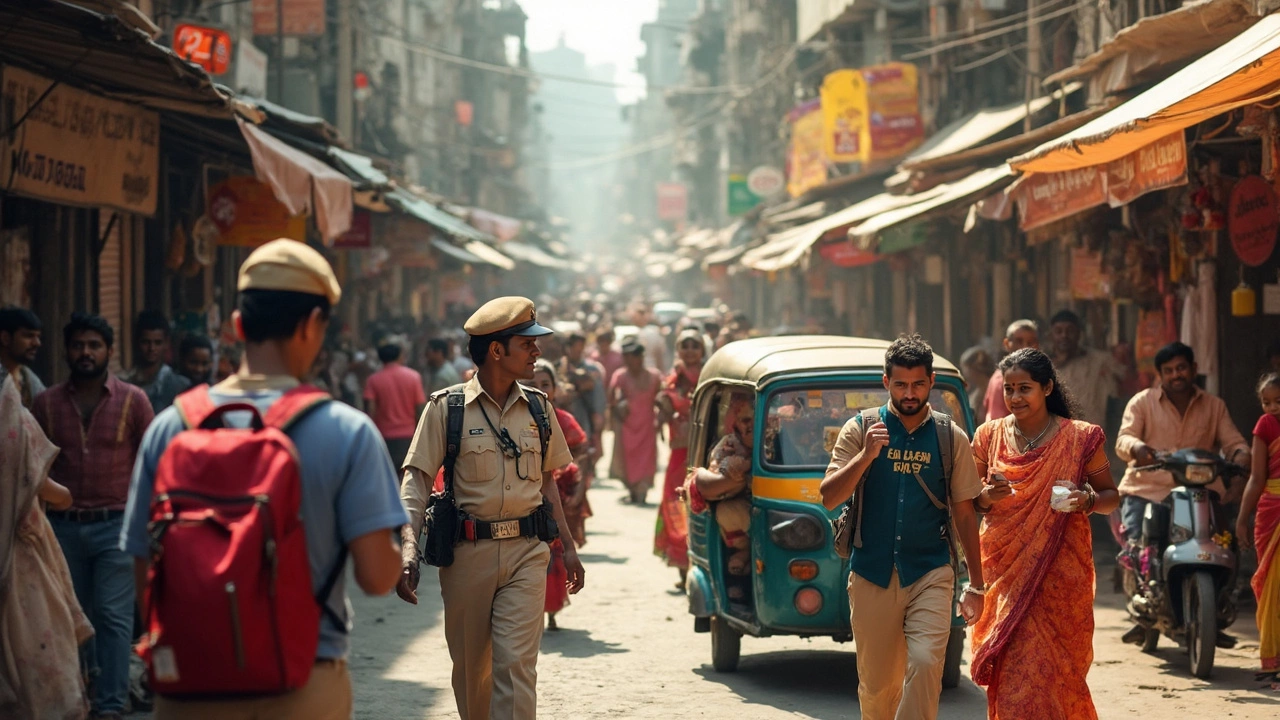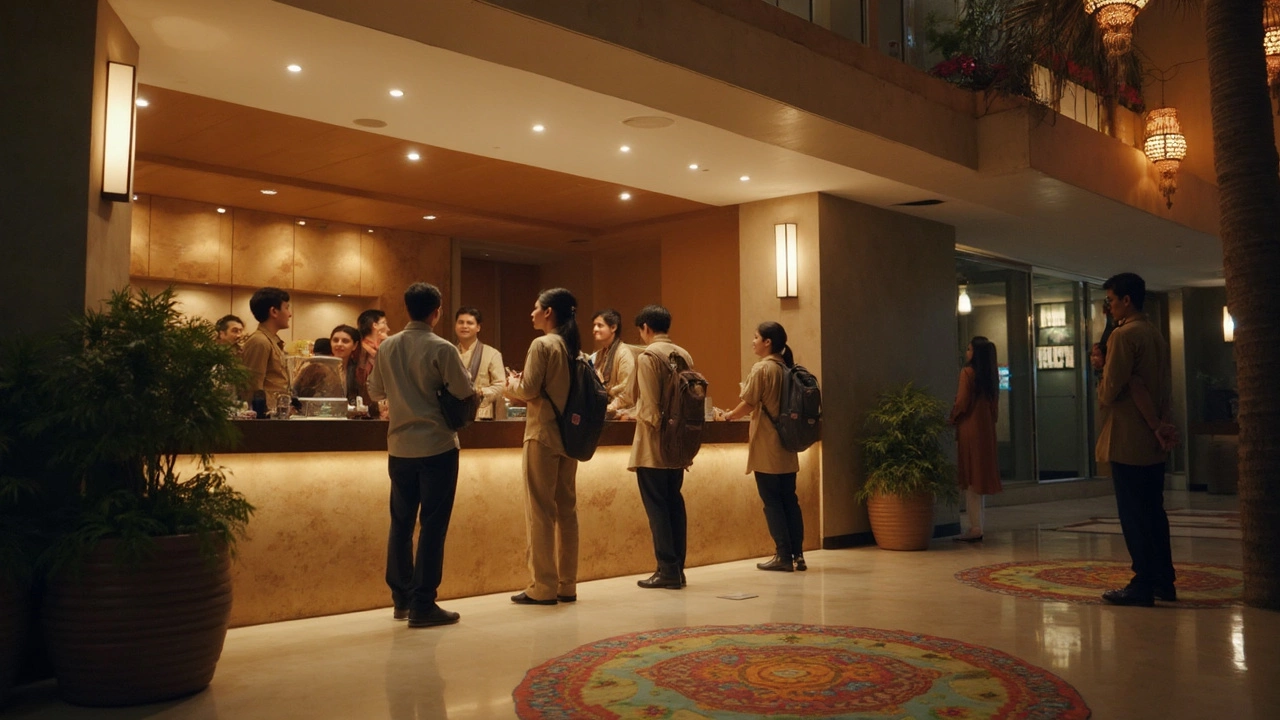How Safe Is India for Tourists? Unpacking Reality, Risks & Tips for 2025
 Jun, 26 2025
Jun, 26 2025
Every year, India's incredible sights draw travelers from every corner of the world. You’ve seen photos of the Taj Mahal at sunrise, the busy lanes of old Delhi, the palm-fringed beaches of Goa... But beneath all that color and life, there’s a question people still ask each other on travel forums: how safe is India for tourists, honestly?
I’ve heard stories—some wild, some comforting—from travelers who fell in love with the place and others who had tough times. In 2025, India is more connected, modern, and buzzing than ever, yet its ancient roots hold tight. This tension is part of what makes judging safety a bit tricky. Let’s cut through easy answers and look at what’s real for anyone thinking about sightseeing, eating their way through street food stalls, or hopping on a tuk-tuk through the chaos.
The Big Picture: India’s Safety Reputation and Realities in 2025
India sees around 18 million international visitors a year, so if it were truly chaotic, word would get out and people would stop coming. But let’s not sugarcoat things: travel here comes with a unique set of challenges, and being informed is half the battle. Crimes against tourists do happen—petty theft, scams, even the occasional violent crime—but it's usually not more frequent here than in other countries with massive populations and big income gaps.
Take, for example, Delhi and Mumbai—India’s two busiest cities. In 2024, a report from the National Crime Records Bureau showed that crimes reported by foreigners made up less than 0.1% of total cases. Most commonly, travelers had problems with pickpocketing or getting ripped off by aggressive touts rather than facing physical danger.
India’s also changed a lot in the last few years. In 2022, police in states like Kerala and Goa began tourist safety patrols in popular spots, and you can spot more tourist help desks in airports and railway stations. The government rolled out the e-Visa system and better English signage around top destinations, trying to make first-timers feel more at ease.
Flip the coin, though, and it’s clear the idea of 'safety' in India goes beyond crime stats. Traffic is wild. Hygiene standards can surprise you, sometimes in a good way, sometimes not. Political protests sometimes spring up without much warning, especially in bigger cities. In June 2024, the intense summer heat sent local hospitals into overdrive, and cases of food poisoning rose when the monsoon washed through North India. And through it all, women travelers—especially those who go solo—keep sharing stories about their experiences, from warm welcomes to unwanted attention.
Is India dangerous for tourists? Not if you keep your wits about you. Treat India like a huge, diverse continent more than a single country. Some states and cities feel instantly relaxed—think the backwaters of Kerala or the Buddhist monasteries in Sikkim. Others, like some parts of Uttar Pradesh or rural Bihar, challenge even seasoned travelers with patchy infrastructure and unclear rules. Don’t judge the whole place by one region, or one wild train ride.
| City | Reported Crimes Against Tourists (2024) | Police Tourist Assistance Centers | Risk Level (1-5)* |
|---|---|---|---|
| Delhi | 673 | 18 | 3 |
| Mumbai | 455 | 14 | 2 |
| Goa | 191 | 9 | 2 |
| Kolkata | 210 | 7 | 2 |
| Varanasi | 172 | 6 | 3 |
| Agra | 110 | 5 | 3 |
*Risk level: 1=Very low, 5=High. Based on reported incidents, tourist feedback, and infrastructure (2024 data).
What Kinds of Risks Do Tourists Face in India?
First, the risks are often less about bad people and more about madly busy places and different ways of doing things. Crowded streets, wild driving, and confusing signs can leave even experienced travelers dazed. Keep in mind: roads are among the most dangerous places in India. According to the Ministry of Road Transport, more than 150,000 people die in road accidents every year. Most visitors don’t face direct threats, but getting hit by a rickshaw or crossing a hectic junction is a real worry, especially in the big cities.
Then there’s the classic travel headaches—pickpockets, bag snatchers, and scam artists. They hang around bustling train stations, main tourist attractions, and sometimes crowded temples. Street children might ask for money, and some touts can be relentless. If you look lost, expect three people to spot you and offer 'help' within a minute. Don’t let politeness trap you into a scam; it’s perfectly fine to say no and keep walking.
Food and drink are huge parts of the Indian experience—but so is the risk of traveler's stomach. If you’re not used to the local water or spicy food, you’ll need to be smart. A 2023 study by the Indian Medical Association found that 4 out of 10 foreign visitors reported minor stomach problems in their first week, more often in the hotter, wetter months. Sticking to busy, popular food stalls and peel-your-own fruit is your best bet. Carrying travel probiotics can help, and many seasoned travelers swear by starting a new local diet slowly.
Natural disasters show up on the danger list, too. Monsoon season, which usually runs from June to September, can cause heavy flooding. In July 2023, the north Indian states saw trains canceled for days and roads swept away unexpectedly. Always check the weather forecast and news updates—India’s mobile networks are quick with alerts these days.
Something not everyone talks about enough: health risks. Not just spicy food, but pollution, mosquito-borne illnesses like dengue and malaria (especially in rural and monsoon-prone areas), and sunstroke. Hospitals in major cities are excellent, but rural clinics can be bare bones. Travel insurance isn’t just a nice-to-have out here—don’t skip it.
Police and locals generally want to help. Still, the legal process can be slow, and sometimes officers might not speak much English, especially far from tourist zones. The India travel safety tip that goes a long way: download the Indian Ministry of Tourism’s official 'Incredible India' app, which includes emergency contacts, tourist police numbers, and local advice.

Is India Safe for Women and Solo Travelers?
Women’s safety is one topic that comes up constantly. There's been plenty of international news coverage about crimes, and some travelers hesitate because of it. How does it really look on the ground, especially in 2025?
The truth is, solo female travel in India is possible and plenty of women do it safely. Major cities like Mumbai and Bangalore are often called the safest for female travelers, and it’s common to see women out with friends after dark. Rural areas are typically more conservative, and some people might stare—sometimes out of curiosity more than anything sinister, but still, you’ll get attention.
Safety tips from regulars include: dressing more conservatively (covering shoulders and knees), avoiding deserted alleys after dark, booking trusted taxis or autos (Uber and Ola are widely available in cities), and picking accommodation with good reviews from other women. Hostels and guesthouses that cater to foreign travelers are usually very aware of common risks and are happy to give insider tips on the area.
Street harassment, locally called 'Eve teasing,' does exist—ranging from staring to catcalls or worse. Avoiding eye contact with persistent harassers and keeping a 'don’t mess with me' attitude helps. Remember, in public transport, there are often women-only sections. Taxis hailed from the street can be a gamble at night, so stick to booking apps, which track the route and driver details.
Solo male travelers usually face little trouble but should also use common sense around nightlife. Spiked drinks, bag theft from hostels, and over-friendly locals offering 'special tours' do crop up, especially in very touristy spots like Goa or Pushkar.
The good news? Smartphone coverage is reliable, English is widely spoken at hotels, and digital payments (PayTM, Google Pay) are everywhere. If you feel uncomfortable, you’ll probably be able to get help quickly—crowds in India notice when someone’s in trouble, for better or worse.
Practical Safety Strategies and Essential Tips for Visiting India
The best travelers treat their visit to India as an adventure with a bit of caution mixed in. Here are the most practical strategies visitors in 2025 are using to stay safe and make the most of the journey:
- Carry a padlock and always lock up your luggage while on trains or at budget guesthouses.
- Keep copies of your passport/visa separate from originals—email them to yourself for backup.
- Don’t walk around late at night alone in deserted areas, even in popular cities.
- Stick to bottled water (make sure the seal’s not broken), and avoid tap water even for brushing teeth.
- Download a reliable maps app (like Google Maps), and save hostel or hotel locations offline.
- Learn the basics: 'no,' 'help,' and 'friend' in Hindi or the local language go a long way.
- Be cautious in busy crowds—keep your backpack in front, close zippers, and don’t flash expensive gear.
- If you take rickshaws or cabs, insist on using the meter, or agree on the fare up front.
- For long train journeys, book upper berths and travel in AC classes if the budget allows.
- Trust your gut—if a taxi driver, guide, or random local seems too pushy, walk away.
- Use only official government-run tour operators for certain regions (the Himalayas, Northeast India).
- In case of emergency, know that the pan-India helpline for tourists is 1363, and police (dial 100) can connect to English speakers in cities.
For food safety, locals will often tell you to eat where families and crowds eat—turnover means fresher food. Skip raw lettuce and ice in drinks unless you trust the restaurant. Peelable fruit, steaming hot curries, and fresh chapati bread are all safe bets.
Watch your step, literally and figuratively. Sidewalks have random holes, cows block lanes, and traffic rules? Drivers treat them more like gentle suggestions. Be patient and chuckle at the chaos—it’s part of the Indian story.
Last thing: travel insurance is not just for hospital emergencies. It covers lost luggage, flight delays, trip interruptions—a lifesaver when things go wrong. As of 2025, more insurers include cover for COVID-related delays or cancellations, so tick that box when booking.